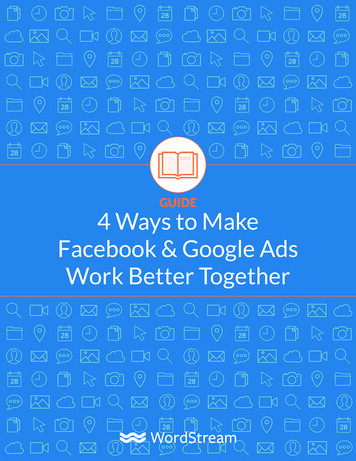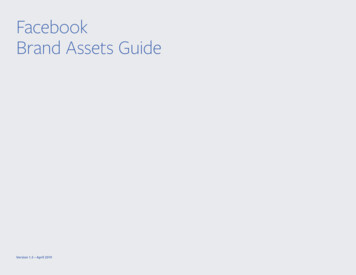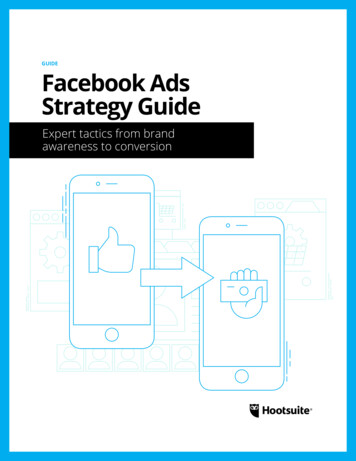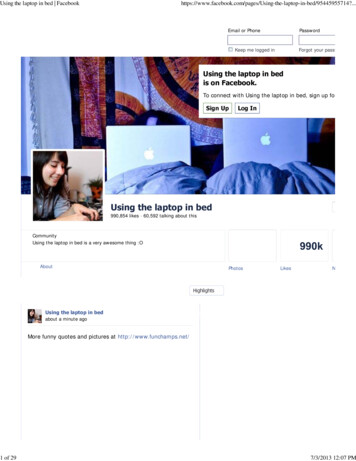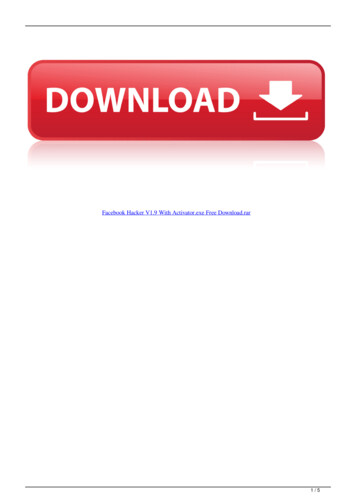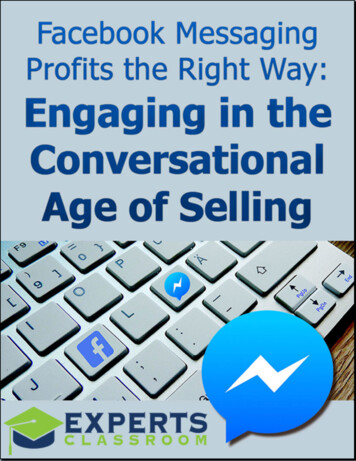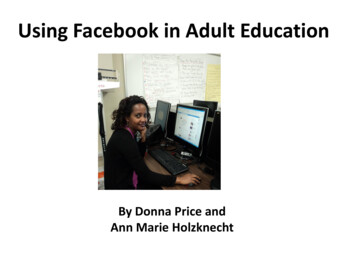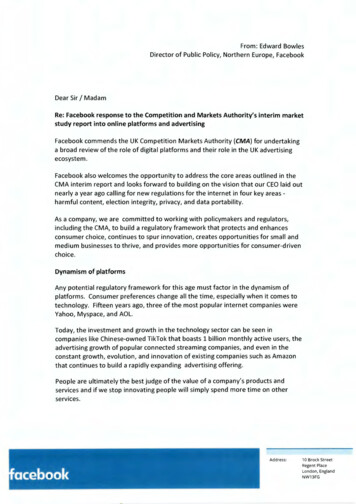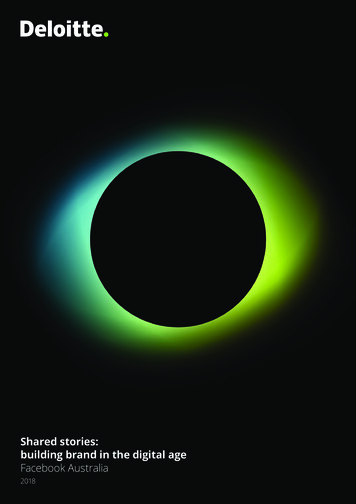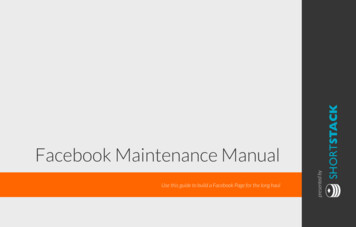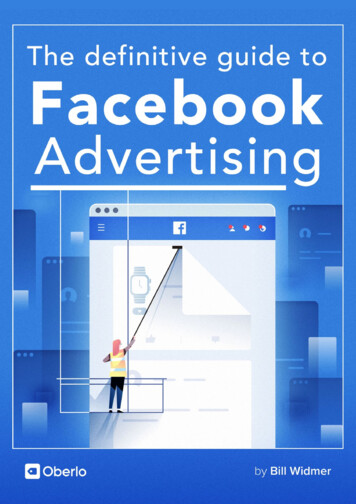
Transcription
Table of ContentsIntroduction1.Facebook Ads Strategy: A Simple GuideStrategy GoalsThe Facebook Ads FunnelTraffic and EngagementExamples of Successful Campaigns2.Advertising CostsHow much do Facebook ads cost?ROIKPIs3.Your First CampaignWhat Is a Facebook Pixel?How to Set Up Your PixelHow to Use Facebook Ads ManagerUnderstanding (And Choosing) Ad ObjectivesTypes of Ad Formats (And Which To Use)How to Create Your First Facebook AdKeeping Your Ad Campaigns Organized4.Custom Audiences and In-Depth Ad TargetingWhat is a Facebook Custom Audience?How to Use Custom AudiencesFacebook Lookalike AudiencesInterest-Based Ad TargetingRemarketing Ads
5.Ad OptimizationAnalytics ReportsAll About Ad FrequencySplit TestingTargeting Other CountriesSeasonality6.Facebook Advertising Strategy FAQsWhat’s a good Ads Budget?How often should I update my ads?Why does my CPC/CPA keep increasing?If I’m already running Google AdWords campaigns, do I still need Facebookads?What if I can’t find my audience on Facebook?Where can I find more Facebook ads resources and help?What tools are available to help me run Facebook ads?Conclusion
1. Facebook Ads Strategy: A Simple Guide5So you have a website or local business and you want to run some Facebook ads.Great!Facebook ads are an excellent way to drive leads and sales toyour business. The best part is that you can set up an ad todayand have money in the bank tomorrow - unlike other marketingmethods, Pay Per Click (PPC) ads have the potential to createimmediate business growth.But let’s back up for a second. First, how should you think about Facebook Adsstrategy? What’s the big picture? To answer that question, we have William Harris, aFacebook Ads expert and the founder of PPC agency Elumynt:“Before you turn on Facebook ads, you needto think critically about your goal.You want sales - obviously - but it’s notalways that easy. If your product is difficultto explain, maybe you need an awarenesscampaign (like a video) before you hit themwith the direct response ad. If your product isWilliam Harris, Elumyntexpensive ( 5,000 ) you might actually needto drive them to a landing page for leads andthen convert them offline.But the bottom line is that you need to seta clear goal before you can execute aneffective Facebook ads strategy.”
1. Facebook Ads Strategy: A Simple Guide6So goal-setting is a big part of Facebook advertising. But you have to keep in mindthat, like any new marketing strategy, Facebook ads have a big learning curve. Youneed to test, tweak, and be prepared to fall on your face a few times before thingssucceed.“Test everything. You are going to be exposedto countless numbers of strategies thatpeople are using for their businesses, thatwon’t always work for yours.In the beginning, you have to have themindset that you are spending money togain data and knowledge as opposed to justJordan Bourque,dropshipping entrepreneurthrowing it away. The more time you spendwithin the ad platform, the more you becomefamiliar with it and learn what works.Don’t get too attached to your campaigns.When I first started, there were times whereI would let ads run longer than I shouldhave. After some time, you become familiarwith the KPIs to look for, and have a betterunderstanding of when to scale or kill acampaign.”
1. Facebook Ads Strategy: A Simple GuideNow, this book will get very technical. Step by step, we’ll guideyou through exactly how to set up, run, test, tweak, and optimizeyour Facebook ads campaigns. You’ll be creating ad campaignswith 48 different ad sets, each testing a different element.It sounds complicated, but we break it down so you know where to go, what to do,and how to do it. You’ll get screenshots for every step, plus videos and GIFs, soyou’re never left guessing about the next action to take.In this chapter, we’ll cover:1. Setting Initial Goals for Your Facebook Ads Strategy2. Visualizing the Facebook Ads Funnel3. What to Expect In Terms of Traffic and Engagement4. Examples of Successful Campaigns (And What You Can Learn FromThem)Let’s get started!7
1. Facebook Ads Strategy: A Simple Guide8Setting Initial Facebook Ads StrategyGoalsLike William shared above, your goal will vary depending on the complexity andcost of your product or services. If you sell a commodity, like clothing or basic homedecor, your ad goal can be strictly sales.But if you sell something expensive (more than 150) or something that peoplearen’t familiar with (like a L’Oréal UV Sense - a small gadget worn on your fingernailthat senses UV radiation), then you may need to run an awareness campaignmeant to build awareness of your brand/product and trust with your audience.For example, check out this ad by LIV Watches:
1. Facebook Ads Strategy: A Simple Guide9Notice the call to action - ‘Learn More’. While this is a sales ad, it’s meant to buildawareness and interest. Even their ad copy is intended to be enticing: “For the manwho won’t be told what to do.”You have to decide for yourself what the intention your FacebookAds strategy will be - sales, leads, or awareness? This issomething only you know, because only you know your products.Visualizing the Facebook Ads FunnelNow that you understand the overarching goals of Facebook ads, let’s dive into anactual ads funnel.A typical sales funnel looks like this:
1. Facebook Ads Strategy: A Simple Guide10An ad leads to a landing page where the visitor buys something. Super easy, right?However, Facebook ads can get much more complicated than this. You can have alead capture campaign that funnels clicks to a lead magnet, such as a free ebook orconsultation, where they enter their contact information. From there, you can sendan email nurture campaign that continues to build trust between your leads andyour brand, until you finally send a promotional email that gets the sale.The complexity of your product and the goals you chose in the previous section willdetermine the length of the purchase funnel. So don’t skip that step!What to Expect In Terms of Trafficand EngagementNow you’re probably wondering - what kind of traffic, engagement, and salesshould I expect when I run a Facebook ad? This is a really difficult question toanswer, but let’s break it down.
1. Facebook Ads Strategy: A Simple GuideAverage Click-Through Rate (CTR)According to a study by WordStream, the average CTR across all industries is 0.90percent.11
1. Facebook Ads Strategy: A Simple Guide12However, this is pretty much because most people are terrible at running Facebookads. They just don’t understand how to target the right audience, run split tests, oroptimize their ads and ad offers to get a decent CTR.Luckily for you, we’ll teach you about all of that in this guide!Average Cost Per Click (CPC)The average cost per click (CPC) for Facebook ads across all industries is 1.72.
1. Facebook Ads Strategy: A Simple GuideBut as you can see, it varies pretty heavily by industry. You’re set if you’re sellingapparel - but if you’re in the finance and insurance industry, expect costs to bemuch higher.Average Conversion Rates (CVR)The average conversion rate for Facebook ads across all industries is a whopping9.21%.13
1. Facebook Ads Strategy: A Simple GuideThat’s pretty dang good for an average, considering the average landing pageconversion rate is a measly 2.35%!That said, there’s a huge gap between industries - the lowest being technology at2.31% and the highest being fitness at an incredible 14.29%. So keep your industryin mind when setting your Facebook Ads strategy.Average Cost Per Action (CPA)CPA is the cost for a specific action on your post, such as link clicks. The averagecost per action (CPA) for Facebook ads across all industries is 18.68.14
1. Facebook Ads Strategy: A Simple Guide15That said, as you can see, it’s skewed pretty heavily by the top five most expensiveindustries:1. Technology2. Home Improvement3. Automotive4. Finance and Insurance5. Industrial ServicesFor everyone else, the ads are significantly cheaper. If that’s you, you’re in luck!Otherwise, things might be a bit pricey for you.That’s it for costs - what about engagement?
1. Facebook Ads Strategy: A Simple Guide16Average Facebook Engagement RateThe average engagement rate of Facebook posts is a measly 0.17%.In other words, it’s really hard to get people to interact with your contentorganically. After all, people are on social media to watch funny videos and interactwith their friends and family - not engage with your advertising content.But obviously, something about Facebook ads works, or peoplewould stop responding to them. So let’s take a look at someincredibly successful ad campaigns and what they did differently!
1. Facebook Ads Strategy: A Simple GuideExamples of Successful Campaigns(And What You Can Learn FromThem)To give you an idea of the full Facebook Ads strategy funnel, I’ve compiled threeFacebook ad examples that worked really well. Let’s dive in!1. Club WClub W ran an excellent ad with a great offer - 3 bottles of wine for 19.17
1. Facebook Ads Strategy: A Simple GuideWhat makes this ad so great:dzdz It’s visual. You can see exactly what you’re getting right in the adimage.dzdz It’s relevant. My aunt LOVES wine, and this showed up in hernewsfeed. That’s about as relevant as it gets!dzdz It has a very enticing value proposition. Three bottles of wine for 19?That’s a steal! I don’t drink a ton of wine, but I’d even take up this offer.dzdz It has a strong call to action. The word ‘get’ is a strong CTA word.It very blatantly tells people to click the box. A time limit would havemade this even better.18
1. Facebook Ads Strategy: A Simple Guide2. CoScheduleI love CoSchedule’s ads. Take a look:19
1. Facebook Ads Strategy: A Simple GuideWhat makes this ad so great:dzdz It’s visual. The color pops out at you among the photos, videos, andtext posts in your feed. And that’s always a good thing!dzdz It’s relevant. I’m a marketer, and nearly all marketers struggle withthe organization of their campaigns. I also run several blogs, so thissoftware could help me.dzdz It uses social proof. 20,000 other marketers and bloggers areusing it? It must be good! As you’ll learn in this guide, social proof is apowerful ad strategy.dzdz It shows you the product. It’s hard to show off software with an image,but they manage to do that well in this ad.20
1. Facebook Ads Strategy: A Simple Guide3. AsosAsos uses dead simple advertising that gets results.21
1. Facebook Ads Strategy: A Simple GuideWhat makes this ad so great:dzdz It’s visual. What you see is what you get - new shoes!dzdz It’s relevant. This was actually a remarketing ad to people who lookedat the shoes on their website. You’ll learn all about remarketing ads inthis guide!dzdz It uses a big, bold, powerful statement. Having a big red box with theword ‘SALE’ in all caps is sure to catch anyone’s eye and make theirears perk up. It’s a powerful word.dzdz They get their audience. The only text - “What? It’s treat day.” - isrelatable. By encouraging you to treat yourself, the copy helps youjustify buying their products.And there you have it! Three successful Facebook ads and the strategies behindwhy they worked. Now, let’s dive into some more specific Facebook advertisingcosts and how to calculate your budget for ad spend.22
2. Advertising Costs24Facebook ads can be a money machine.It’s every entrepreneur’s dream to create something that makes more money thanwhat you spend.Of course, you can only achieve that if you get advertising right. And wingingsomething like Facebook ads is a quick way to burn a hole in your wallet.That’s why we created this eBook - to help you learn how to turnyour Facebook ads into a money-making machine. And to helpyou lower your Facebook advertising costs and increase yourROI.Why Facebook ads?Because Facebook has proven to be the largest social media outlet with the mostoptions for targeting new (and current) customers to your website.And with over 3 million business advertisers sharing success stories on Facebook,it’s easily one of the best platforms to use to grow for your online business.In this quick intro chapter, we’ll cover how much Facebook ads cost, what kind ofan ROI you can expect, and how to set goals and KPIs before diving into setting upyour first Facebook campaign in Chapter 3. Let’s get started!
2. Advertising Costs25Here’s a quick glossary of terms and acronyms to help you understand everything:CPCCost Per ClickCPMCost Per 1,000 ImpressionsCPACost Per AcquisitionROIReturn on InvestmentCVRConversion RateCTRClick-Through RateHow much you pay wheneversomeone clicks on your adHow much you pay per 1,000 viewsof your adHow much you pay to acquire a newcustomer from an adThe money you make back fromyour ad spendThe percentage of people thatconvert from your adHow many people click on your adafter seeing itA metric to compare yourKPIKey Performance Indicatorperformance to, to ensure you’re ontrack to reach your goals
2. Advertising Costs26How much do Facebook ads cost?In a study done by AdEspresso, the average CPC (cost per click) on Facebook in2016 was between 0.20- 0.80. In the US specifically, the cost averaged 0.26 perclick.
2. Advertising Costs27Naturally, costs have risen since a few years ago. But it’s safe to say that ad costshaven’t risen too much. 0.20 to 0.80 per click is still a good benchmark for yourreference.Many factors affect this CPC, as well as the Facebook CPM (cost per 1,000impressions, or views, of your ad), including:dzdz Your audience targetingdzdz The engagement levels and relevance score of your addzdz The time of yeardzdz Your campaign objectivedzdz The maturity of your Facebook pixelLet’s talk about each of these a bit more.
2. Advertising CostsHow your audience affects Facebook ads pricingAccording to that same study by AdEspresso, it costs more to target people age55-64 than to target people age 18-24.28
2. Advertising Costs29Additionally, women are more expensive to target with ads than men (for Facebook‘likes’ at least).This doesn’t mean that you’ll struggle if you’re targeting women age 55-64;it just means you’ll need to work harder to nail down your offer and audienceengagement to lower your Facebook advertising costs, which we’ll talk about in thenext section.We’ll also discuss audience targeting in-depth in Chapter 4.
2. Advertising Costs30How engagement and relevance score affect your CPCYou know how Facebook’s algorithm shows your posts to more people if it receivesa lot of engagement shortly after publishing?This holds true for Facebook ads as well. In fact, every ad you purchase receivesa relevance score by Facebook based on that ad’s engagement and relevance toyour audience.For example, if you run a Facebook campaign about puppy food to people whohate puppies (that is, nobody), your CPC and Facebook CPM will be through theroof because your ad is completely irrelevant.The higher your relevance score, the lower your CPC and thehigher your click-through rate will be. In other words, more salesfor less money.How Relevance Score affects CPC and click-through rate (Image Source)
2. Advertising CostsLook at the huge difference between a 9 and a 10: we’re talking almost triple theclick-through rate with less than half the cost per click. A measly 0.03 per click!How do you get a higher relevance score? We’ll cover that in Chapter 5 when wediscuss optimizing your campaigns.Time of year and Facebook ad costsFacebook ads work on a bidding system, sort of like Facebook ad auctions.You place a bid on how much you’d like to spend per click. (Facebook does thisautomatically for you unless you use the advanced settings. More on that inChapter 4.)Because of this, when lots of marketers are buying Facebookcampaigns at the same time, the bidding cost goes up.Specifically, during major shopping holidays like Christmas andBlack Friday, Facebook CPC goes through the roof.AdEspresso found that cost per app install skyrockets in November and earlyDecember, likely due to the holidays.31
2. Advertising Costs32While not the same as CPC, cost per app install tends to increase and decrease injunction with CPC, so you can view the trends similarly.The takeaway? Expect higher Facebook advertising costs during major holidays. Ifyou don’t need to advertise during those holidays, allocate more of your advertisingbudget in the spring and summer months.That said, if you still make a profit despite the higher costs (factoring in customerlifetime value, which we’ll cover in the next section), you should continue to runthem year-round.
2. Advertising CostsYour Facebook Campaign Objective and how it affectscostsWhenever you start a new campaign, you have to choose from a list of adobjectives.They fall into three categories:1. Awareness - when you just want people to know about you.2. Consideration - when people are aware of you and considering yourproduct vs. a competitor’s product.3. Conversion - when people are ready to buy33
2. Advertising Costs34These objectives get progressively more expensive as you get closer to the sale.Reach and lead capture campaigns are the most expensive, which makes sense.We’ll further discuss ad campaign objectives in Chapter 3.How your Facebook pixel affects Facebook advertisingcostsYour Facebook pixel is a snippet of code. You put this code on the pages of yoursite to collect data on whoever visits the site. We’ll discuss how to set it up andwhat it does further in Chapter 3, but for now, know this:As your pixel collects data on the people who tend to click on and purchase fromyour ads, it uses machine-learning to learn who your best target market is. This iscalled ‘maturing’ your pixel, and it’s done simply by running ads over time.As your pixel learns who your best customers are, it can improve your Facebookaudience targeting to target people similar to past customers who are more likelyto buy. This lowers your CPC while simultaneously increasing your click-throughand conversion rates.You can also use your pixel to run remarketing campaigns and create lookalikeaudiences, but you’ll learn all about that in Chapter 4. Just know that you definitelyneed to install the pixel if you want to run successful Facebook ads!Now that you understand Facebook ads pricing, let’s talk aboutthe important part - return on investment!
2. Advertising Costs35What’s the ROI on Facebook ads?There are multiple case studies suggesting the average ROI of Facebook ads issomewhere around 400-450%.Of course, that percentage varies massively by industry and the profit you make onyour products or services. So take it with a grain of salt.The real reason for this section isn’t to give you an exact numberto expect as a return, but rather to set some expectations andexplain how to calculate your own ROI.Word of warning: It’s highly likely you will lose money on Facebook ads at first.In fact, many people continually lose money on their ads in order to get newcustomers, then make up for that loss with remarketing and lookalike audiencecampaigns.To make sure you’re still making money in the long run, you need to understandyour cost per acquisition (CPA) and your customer lifetime value (CLV).CPA is how much you need to spend on ads before actually acquiring a customer.You need to know your conversion rate (CRV) to get this answer.For example, if you need 10 clicks to get one customer, and your CPC is 1, yourCPA would be 10.Avg. # Clicks Per Sale * CPC CPA10 * 1 10
2. Advertising Costs36Your CLV is how much money you make over the lifetime of a customer.If they spend 10 on that initial ad, you break even (or lose money if you have othercosts). But if they come back to your store from a remarketing campaign and theCPA for the remarketing ad is only 2, then you make 8 ( 10 - 2).Avg. Order Value * # Of Orders Per Year * # of Years asa Customer CLV 10 * 10 * 1 100If they purchase from you 10 more times over the course of a yea
1. Facebook Ads Strategy: A Simple Guide 6 So goal-setting is a big part of Facebook advertising. But you have to keep in mind that, like any new marketing strategy, Facebook ads have a big learning curve. You need to test, tweak, and be prepared to fall on your face a few times before thin

